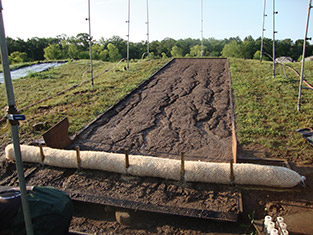
Soil Loss from Rainfall-Induced Erosion
A proposed new ASTM International standard will provide performance-based data of sediment control devices to regulating entities, specifiers, consumers and manufacturers. WK11340, Test Method for Determination of Sediment Control Product's Ability to Reduce Soil Loss Associated with Rainfall-Induced Erosion, is being developed by Subcommittee D18.25 on Erosion and Sediment Control Technology, part of ASTM International Committee D18 on Soil and Rock.
According to Ryan Vavra, manager, ErosionLab, American Excelsior Co., and a D18.25 member, sediment control devices are a fairly new category of products with few tests available to provide information on how the product performs after it has been installed. The main function of these devices is to trap or filter sediment in water. Sedmient control devices are installed perpendicular to flow in ditches and are also used as slope interruption devices.
Other areas in which sediment control devices are used include soil stock piles, in front of and around storm water inlets, and around the perimeter of job sites.
"It is relatively easy to measure the physical properties of sediment control devices, but it is more challenging to provide information on a product's ability to perform in the field," says Vavra. Once approved, WK11340 will provide quantitative data on the field performance of sediment control devices.
The proposed standard will provide the means to calculate a support practice factor (P factor), one of the six components of the Revised Universal Soil Loss Equation (known as RUSLE), which is used to calculate estimated soil loss. The calculated P factor would indicate how well a sediment control device traps or filters sediment.
"Users of sediment control devices will be able to look at the P factor of a sediment control device and know how it will perform when installed properly in the field," says Vavra. "This will give users confidence the product they select will be compatible to the application that it is used in. This could potentially lead to better sediment control and less soil loss."
All interested parties, particularly those who write erosion and sediment control plans, state and federal government officials, manufacturers and engineers, are encouraged to join in D18.25 in the ongoing development of WK11340.
CONTACT Technical Information: Ryan Vavra, American Excelsior Co. • Rice Lake, Wis. • Phone: 715-236-5656 • Email: rvavra@americanexcelsior.com O ASTM Staff: Robert Morgan • Phone: 610-832-9732 • Email: rmorgan@astm.org O Upcoming Meeting: June 9-12 • June Committee Week • Indianapolis, Ind.
 SN Home
SN Home Archive
Archive Advertisers
Advertisers Masthead
Masthead RateCard
RateCard Subscribe
Subscribe Email Editor
Email Editor